Introduction: Functional fitness is more than just a workout routine; it’s a philosophy that emphasizes training the body for real-world activities and improving overall well-being. This article explores the principles of functional fitness and how incorporating them into your exercise regimen can enhance your everyday life.
I. Understanding Functional Fitness A. Definition: Define functional fitness as a training approach that focuses on exercises mimicking everyday movements, emphasizing strength, flexibility, and balance. B. Core Principles: Discuss the core principles of functional fitness, including the integration of multi-joint movements, engagement of stabilizing muscles, and adaptability to various activities.
II. Real-World Applications A. Functional Movements: Explore examples of functional movements, such as squats, lunges, and pushing or pulling motions, and how they directly translate to activities like bending, lifting, and reaching in daily life. B. Improved Mobility: Discuss how functional fitness enhances mobility, making activities like climbing stairs, getting in and out of a car, or reaching for items on shelves more manageable.
III. Benefits for Everyday Activities A. Enhanced Balance: Highlight the role of functional fitness in improving balance and stability, contributing to safer navigation of uneven surfaces or performing activities that require coordination. B. Increased Strength: Discuss the overall strength gains associated with functional fitness and how they contribute to tasks like carrying groceries, lifting children, or moving furniture.
IV. Accessibility and Adaptability A. Minimal Equipment: Emphasize the accessibility of functional fitness, requiring minimal equipment and making it suitable for home workouts or those with limited access to a gym. B. Adaptability to All Fitness Levels: Discuss how functional fitness can be tailored to accommodate various fitness levels and ages, making it an inclusive approach for individuals of all backgrounds.
V. Holistic Well-Being A. Injury Prevention: Explore how functional fitness, by addressing imbalances and improving joint stability, contributes to injury prevention, allowing individuals to engage in activities without the fear of strains or injuries. B. Mental Health Benefits: Discuss the positive impact of functional fitness on mental well-being, including stress reduction, improved mood, and enhanced cognitive function.
VI. Functional Fitness Exercises A. Bodyweight Movements: Introduce key bodyweight exercises like squats, lunges, push-ups, and planks that form the foundation of functional fitness. B. Incorporating Tools: Discuss how incorporating tools such as resistance bands, medicine balls, and kettlebells can add variety and progression to functional workouts.
VII. Integrating Functional Fitness into Your Routine A. Daily Movement: Encourage the integration of functional movements into daily activities, such as sitting down and standing up from a chair with proper form. B. Structured Workouts: Provide sample workout routines that incorporate functional fitness principles, promoting a balanced approach targeting different movement patterns.
Conclusion: Functional fitness transcends traditional exercise routines, offering a holistic approach to health and well-being. By aligning your workouts with the principles of functional fitness, you not only build physical resilience but also cultivate a foundation for a more dynamic and fulfilling everyday life. Elevate your living through functional fitness—a journey towards a stronger, more adaptable, and balanced you.

